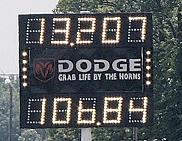-
1/4m Trap speed vs. power

Ever wondered if those big BHP claims that tuners and the like make are true ? When it comes to tuners very few claims are accurate,
it doesn't pay to be modest ;-)
So how do you know how much power a car really has ?
A rolling road ? - not really, too many fudge factors here. They're a good laugh and a handy tool but don't take their results as gospel.
Sometimes they're no where near the right figure at all, readings can be low and others inordinately high. I've had rolling
road printouts for over 400hp, the operator assured me it was right, I actually had about 250hp - I knew this before I went.
Every rolling road I went to before and after that event gave me a different reading again. Rolling roads are especially
no good if your car is light and has a big steep torque curve that's likely to get the wheels spinning, rarther like a big-boosted R5GTT!
In order for a rolling road to be accurate you have to;
a) prevent wheelspin completley - wheelspin happens often, sometimes when you can't see it, there can be a degree of slip.
b) measure wheel power instead of flywheel power - at best flywheel figures are a guess by the computer, supposidly calculated from drag.
c) know that the dyno itself is calibrated.
Generally they are better suited to (often lower powered) n/a cars with smooth torque curves. This isn't to say that good, well engineered
rolling roads don't exist.
A Hub dyno ? - getting closer - they have a distinct advantage over rolling roads because wheel spin can no longer be an error
factor in our readings. Clutch slip might be though. Its on the operator to keep track of the recorded RPM and the actual engine
RPM - if the 2 spread apart then something's slipping. The only hub dyno I've sampled for myself was Thor's, very nice I thought,
and more importantly they insisted on providing only wheel HP figures so removing the need for the computer to guess the transmission
loss.
So, short of removing the engine and placing it on a 100 grand bench dyno how can we really know how much power a car has ?
The only system you can't easilly fool - the drag strip.
A drag strip has nearly no erroneous features, its just a track with timing gear, not much to fool.
The rule is that a car's wheel power is almost perfectly related to 2 things; its weight and its trap speed.
Ok, you can argue that areodynamics, gear ratios and such like play a part, because they do, but its a small enough percentage not to worry about.
A drag strip 1/4 mile records 2 main details - ET (elapsed time, the actual 1/4m time) and trap speed, sometimes called terminal speed.
Trap speed is the speed at which the car goes through the final pair of beams at the end of the run. It is easy to see that the more power
you have the greater the trap speed will be. You also need to know that the quality of launch (good or bad) has next to no
bearing on the trap speed, so you can dismiss those claims of "ahh mate, I had no grip in 1st gear, innit, the track was slippery..".
There's some pretty good java calculators on the web that let you input weight and speed to give you a fairly accurate wheel HP figure. I use a drag simulator that takes into account a full torque curve, basic aerodynamics,
gear ratios, shift RPM's, tyre height, etc but essentially it does the same thing only with a little more accuracy.
Here is a list I compiled that relates trap speed to approximate flywheel BHP (assuming a roughly standard weight R5GTT):
(Treat it as a guide, but I assure you the real figure will not be far from the following ;-) )
120hp - 86mph
130hp - 90mph
140hp - 92mph
150hp - 94mph
160hp - 96mph
170hp - 98mph
180hp - 101mph
190hp - 103mph
200hp - 105mph
210hp - 107mph
220hp - 108mph
230hp - 110mph - this is a common one because after this point it gets increasingly difficult to make more power with the c1j.
240hp - 112mph
250hp - 113mph
260hp - 115mph
270hp - 116mph
280hp - 118mph
290hp - 119mph
300hp - 120mph
310hp - 122mph
320hp - 123mph
If you fancy a quick play with a reputable calculator try the one on Ray Hall's website:
www.turbofast.com.au/Drag.html
Happy tuning, steer clear of the B/S. Scoff
 Posting Permissions
Posting Permissions
- You may not post new threads
- You may not post replies
- You may not post attachments
- You may not edit your posts
-
Forum Rules







 Reply With Quote
Reply With Quote